#Dale Tremont
Explore tagged Tumblr posts
Text


Happy Birthday Ginger
July 16 1911
#Ginger Rogers#Top Hat#Dale Tremont#Virginia Katherine McMath#Happy Birthday Ginger!#Loml#my gifs#movie edits#movies : Classic
25 notes
·
View notes
Text

Peak Ginger
6 notes
·
View notes
Text
"Look, Rambo. Heaven."
They all looked at the television. On the screen, Jerry Travers and Dale Tremont were dancing cheek to cheek.
-TJ Klune, In The Lives of Puppets
4 notes
·
View notes
Text
Heaven, I'm in heaven...
Script below the break
Hello and welcome back to The Rewatch Rewind! My name is Jane, and this is the podcast where I count down my top 40 most frequently rewatched films in a 20-year period. Today I will be discussing number five on my list: RKO’s 1935 musical comedy Top Hat, directed by Mark Sandrich, written by Allan Scott and Dwight Taylor, and starring Fred Astaire and Ginger Rogers.
American dancer Jerry Travers (Fred Astaire) comes to London to star in a show produced by his friend Horace Hardwick (Edward Everett Horton). The night before the show opens, Jerry’s tapdancing in Horace’s hotel room awakens model Dale Tremont (Ginger Rogers) in the room below. She calls the manager to complain, who calls the room above hers, and Horace answers the phone. Because he can’t hear over Jerry’s dancing, he leaves to see what the manager wants. Tired of waiting for the noise to stop, Dale storms upstairs to confront the dancer. Upon seeing her, Jerry immediately falls in love, and the next day he starts following her around in a mildly creepy but mostly charming way. However, he never tells her his name, and when Dale learns that her friend Madge Hardwick (Helen Broderick)’s husband is staying in the room above hers, she naturally assumes that Jerry is Horace Hardwick. All of this results in much confusion, hilarity, and of course, dancing.
Top Hat was one of the many old movies that my mom introduced me to in 2002, and it has been among my favorite films ever since. I had already seen it several times before I started keeping track, and then I watched it five times in 2003, three times in 2004, three times in 2005, once in 2006, once in 2009, twice in 2010, three times in 2011, four times in 2012, once each in 2013, 2014, 2016, 2017, and 2018, twice in 2020, once in 2021, and once in 2022. This was the first Fred and Ginger movie I ever saw, and while I’ve since watched and enjoyed all nine others multiple times, none could top Top Hat, in my opinion.
This was the fourth film that Fred and Ginger made together, but only the second in which they had starring roles, and the first that was written specifically for them. Two of their previous films – 1933’s Flying Down to Rio and 1935’s Roberta – gave them relatively small parts, although their scenes were unquestionably the highlights. In Flying Down to Rio, they got fourth and fifth billing and are barely in it, but they caused a splash with their one dance number, and an iconic duo was born. They got second and third billing in Roberta, in which they basically function as the B romantic pair, with Irene Dunne and Randolph Scott as the A couple. Fred and Ginger’s first starring roles had been in 1934’s The Gay Divorcee, which was an adaptation of the Broadway musical Gay Divorce. Critics of Top Hat (including Astaire himself) complained that it was basically a rehash of The Gay Divorcee, and like, I can see their point: both films have a weird mistaken identity story and feature essentially the same cast filling very similar roles – with the notable change from Alice Brady to Helen Broderick in the “Ginger’s older relative/friend” role. But while I also enjoy The Gay Divorcee, somehow I feel like Top Hat just works better. The story makes at least a little bit more sense, and they didn’t devote a quarter of the runtime to a single interminable musical number like The Gay Divorcee did with the frickin Continental… although The Piccolino came dangerously close to replicating that. After Top Hat, Fred and Ginger made five more films with RKO in the 1930s: 1936’s Follow the Fleet, in which they were basically the B couple like they had been in Roberta, although they did get top billing in this one; 1936’s Swing Time, which is mostly very good and would probably have made it onto this podcast if not for that one blackface number; 1937’s Shall We Dance, which I kind of slept on for a while but now I think is probably my second favorite of theirs, although the ending drags a bit; 1938’s Carefree, possibly their weirdest movie, which involves hypnotism; and 1939’s The Story of Vernon and Irene Castle, which I find to be disappointingly forgettable. Then, after 10 years apart, they reunited for MGM’s The Barkleys of Broadway in 1949, which is basically Fred and Ginger fan fiction and it makes me so happy that it exists.
While there were lots of other dancing musicals being made in Hollywood around this time, the Astaire/Rogers ones feel like their own genre, and not just because of the stars. I think a big part of what makes Top Hat feel like the quintessential Fred and Ginger film is the supporting cast. Edward Everett Horton, Helen Broderick, Erik Rhodes, and Eric Blore were each in at least one other Fred and Ginger movie, but this is the only one that has all four of them. Edward Everett Horton excelled at playing the kind of guy who thinks he’s in control of every situation, but actually has no clue what’s going on, and he’s especially in his element as Horace Hardwick, convinced that he can get to the bottom of everyone’s strange behavior while never suspecting that he could end all the confusion just by meeting Dale. Helen Broderick delivers wisecracks in a brilliantly dry, cynical tone that contrasts with Horton’s bumbling to great comedic effect. Their characters don’t seem to have a very functional marriage, but they also don’t really seem to mind that. Typically the “haha, married couples hate each other” types of jokes really irritate me, but Horace and Madge are such ridiculous characters that it’s actually kind of funny when they do it. And then there’s Erik Rhodes, whose absurdly over-the-top Italian characterization in Top Hat and The Gay Divorcee so offended Mussolini that both those films were banned in Italy. Personally I feel like Top Hat’s portrayal of Venice as a giant white soundstage is probably more insulting to Italians than a guy doing a bad accent and being silly is, but I don’t know, maybe it’s still offensive. To me, as a non-Italian, I just think Erik Rhodes is very funny as Alberto Beddini, the dressmaker whose clothes Dale is modeling. He has some truly excellent lines, like, “Never again will I allow women to wear my dresses!” and “I am no man; I am Beddini!” Despite his declarations of love for Dale, he is extremely queer-coded, while also interestingly being one of the most masculine characters in the film, which is…kind of the opposite of how male characters are typically queer-coded. So Alberto is very silly but also quite fascinating. Eric Blore was in half of the Fred and Ginger movies and he’s always hilarious. In Top Hat he plays Horace’s valet, Bates, who always refer to themselves in the plural (“We are Bates, sir”), so the next time someone complains to you about this so-called newfangled trend of young people messing with pronouns, feel free to point out that at least one middle-aged man was doing that way back in 1935. One of my favorite exchanges in the movie is when Horace is trying to explain to Bates that Jerry seems to have gotten into a perilous situation with a woman by saying, “He has practically put his foot right into a hornets’ nest” and Bates respond with, “But hornets’ nests grow on trees, sir.” “Never mind that. We have got to do something.” “What about rubbing it with butter, sir?” “You blasted fool, you can’t rub a girl with butter!” “My sister got into a hornets’ nest and we rubbed HER with butter, sir!” “That’s the wrong treatment, you should have used mud – never mind that!” It has nothing to do with anything but it makes me laugh every time. This supporting cast adds a silly, somewhat Vaudevillian aspect to Top Hat that no Fred and Ginger film would be complete without.
Of course, Fred and Ginger movies are better known for a different somewhat Vaudevillian aspect: their songs. It’s very interesting to watch Top Hat from a musical history perspective because it was made before the advent of the book musical – that is, a show where the songs are fully integrated into the story and used to tell a specific narrative. The songs in this movie do sort of advance the plot, but the lyrics are generic enough that they stand alone completely out of context. It’s kind of a bridge between the disjointed songs and scenes of vaudeville and the continuously flowing story of book musicals. All the music in Top Hat was written by the legendary Irving Berlin, including two solo numbers for Fred: “No Strings (I’m Fancy Free)” which is what Jerry is dancing to in the hotel when he disturbs Dale, and “Top Hat, White Tie and Tails” which is part of his show; and three numbers for both Fred and Ginger to dance to: “Isn’t This a Lovely Day (to Be Caught in the Rain)?” for soon after they meet, before Dale thinks that Jerry is Horace, “Cheek to Cheek” when they’re in love but Dale is conflicted because she thinks he’s married to Madge, who is confusingly encouraging them to dance, and “The Piccolino” after Dale finally learns Jerry’s true identity. Both Astaire and Rogers were significantly better dancers than singers, but typically Fred did most of the singing, and the only song he doesn’t sing in Top Hat is the Piccolino, apparently because he didn’t like it, so Ginger sings it first and then an offscreen chorus repeats it. My favorite number in the film has always been “Isn’t this a Lovely Day (to Be Caught in the Rain)?” because I love the way Jerry starts dancing fancier and fancier and is pleasantly surprised that Dale can keep up with him, and it’s fun that Ginger got to wear pants for once, and I also just really enjoy that song. There was a time soon after I first fell in love with this movie when I tried to make saying the word “lovely” a lot part of my personality, mainly inspired by this song. I truly enjoy all the numbers, even if I do think The Piccolino goes on a bit too long, although, again, it’s not nearly as painfully long as The Continental in The Gay Divorcee, which it’s clearly meant to pay homage to. But Fred and Ginger’s most famous dance number – certainly in this film, and also probably in any of their films – is “Cheek to Cheek.” It is pure, breathtaking magic, and even knowing about the major drama with Ginger’s dress in no way detracts from that.
I’ve heard a few different accounts of the dress drama with slightly conflicting details, but what they all seem to agree on is that Ginger Rogers insisted that a low-backed, light blue, ostrich feather dress would look perfect during the “Cheek to Cheek” dance, and pretty much everybody else tried to talk her out of it, but she refused to back down until they were all forced to concede. And she was correct, it looks incredible, although if you’re watching closely you can see some feathers falling off while she dances, which was the main objection to the dress. Fred Astaire was reportedly extremely annoyed about the flying feathers, although he betrays none of that to the audience, and afterwards gave Ginger the nickname “Feathers,” which he continued to call her for many years. My interpretation of this is that it started as kind of an insult when he was genuinely upset about the incident but evolved to become more of a term of endearment, although obviously I don’t know for sure. As far as I can tell, apart from the occasional disagreement, Fred and Ginger got along pretty well in real life, although the studio sometimes invented or exaggerated stories about them fighting to try to generate more buzz. Personally I don’t think that was necessary; their talent spoke for itself, and audiences would have flocked to their films whether or not there was conflict offscreen.
One thing that I don’t like about old movies is that in general, most of the people who worked on them were deceased before DVDs were invented, which means that the special features are often lacking. I have watched Top Hat with commentary, but it’s by a film historian and Fred Astaire’s daughter who was born after this movie was made. It’s mostly the historian talking, but every once in a while Astaire’s daughter shares a memory of her father, and every. single. time. the historian responds with, in the most patronizing tone of voice I’ve ever heard, “Thank you for telling us that” and I hate it so much. But one thing that I did learn from the commentary that I definitely wouldn’t have noticed if nobody had told me is that Lucille Ball makes a very small appearance in this movie as a worker at the flower shop in the London hotel. She has a couple of lines, but even though I’m used to watching her in Stage Door, which was only made two years after Top Hat, I absolutely would never have recognized her. So that’s kind of fun.
Now, when it comes to watching Top Hat from an aroace perspective, even I cannot deny that this movie in general, and the “Cheek to Cheek” number specifically, is extremely romantic. The main storyline is Jerry immediately falling for Dale and flirting with her until she falls for him, and then her attempting to suppress her feelings when she thinks he’s married to her best friend. But somehow, even watching it as a young teen who had no idea that I was aroace, this felt different from other romantic films I’d seen. I remember feeling irritated the first time I read a description of Fred and Ginger’s dancing as their version of making love because “ugh, why do people have to make everything about sex?” It took me a while to realize that not only is that an apt description, but it’s also part of what drew me to them in the first place. Because despite the way the terms “making love” and “being intimate” are now used almost exclusively as synonyms for “having sex,” they don’t necessarily have to be. There are other ways of experiencing and expressing love and intimacy besides sex. It’s just that our allonormative society puts sex on such a high pedestal and portrays it as the One True Form of Intimacy that all other forms are devalued to the point that often they feel barely worth mentioning. And I do feel like when some people talk about Fred and Ginger this way, what they’re implying is “Their dances were the Hays Code era version of sex scenes.” And, granted, it’s quite possible that that was the intent. But nothing about their dancing is inherently sexual, and yet, it would be hard to deny that it’s extremely intimate. So as someone who craves non-sexual intimacy, in a world where that concept almost seems oxymoronic, it’s so encouraging to see these characters express that. Of course, I don’t want exactly what they have – for one thing, I’m a terrible dancer, despite my one year of tap lessons in 2nd grade. And for another, what they have is way too romantic for me. But although I could never have articulated this at the time, just seeing this example of extreme intimacy coming in other, non-sexual forms as a young obliviously asexual person was so important. It gave me some armor against the onslaught of allo- and amatonormative messages implying that sexual relationships are inherently more valuable and valid than any other kind of relationship. Top Hat ends with the implication that Jerry and Dale are about to get married, so I guess we’re meant to infer that their relationship will eventually become sexual, but I don’t see how anyone could watch this movie and still think that a sexless marriage consisting of dance numbers like “Cheek to Cheek” would be any less valid than a sexual marriage. Like so many of my favorite movies, it’s not exactly ace representation, but it’s easy to imagine many of the characters in Top Hat as ace, and often that’s as good as it gets.
While the subtle and probably unintentional message that sex doesn’t have to be the end all be all is great, the main reason I love this movie is because it’s just a lot of fun to watch. I’ll be the first to admit that the plot is a little ridiculous and doesn’t make a ton of sense, but I also have to admire the lengths they go to in order to maintain the mistaken identity for so long. Like the part when the London hotel manager tells Dale that Horace Hardwick is the gentleman with the briefcase and cane on the mezzanine, and Horace steps behind a chandelier before Dale can see him, and while she’s trying to get closer, Jerry runs up to Horace and says that he has a phone call, and Horace hands Jerry his briefcase and cane and rushes off, so Dale will see Jerry alone holding a briefcase and cane and therefore still think he is Horace. Or when Horace just happens to be in the bathtub when Dale comes into their room in Italy. Or how Jerry tells Madge that he’s met Dale so she doesn’t think she needs to introduce him. It’s like simultaneously the most far-fetched, bizarre plot imaginable and also kind of brilliantly executed, and I love it for that. And even if the plot doesn’t work for you, this movie is still worth watching for its truly phenomenal dancing by one of the most iconic pairs in Hollywood history.
Thank you for listening to me discuss another of my most frequently rewatched films. When compiling this list, I was very surprised to discover that Fred Astaire would only appear in one film, since I consider him one of my faves, but I hope he would at least be happy to know that that one film is in my top five. Next week, I will be talking about another Old Hollywood musical that I watched two more times than Top Hat, for a total of 33 views, which stars a man who is often compared to Fred Astaire, although I feel like, apart from being dancers, they were very different. So stay tuned for that, and as always, I will leave you with a quote from that next movie: “I make more money than…than…than Calvin Coolidge! Put together!”
6 notes
·
View notes
Text










♡ ♫
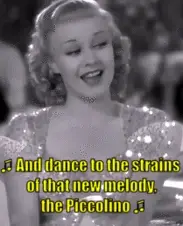
Ginger Rogers as Dale Tremont
Top Hat (1935)
0 notes
Photo
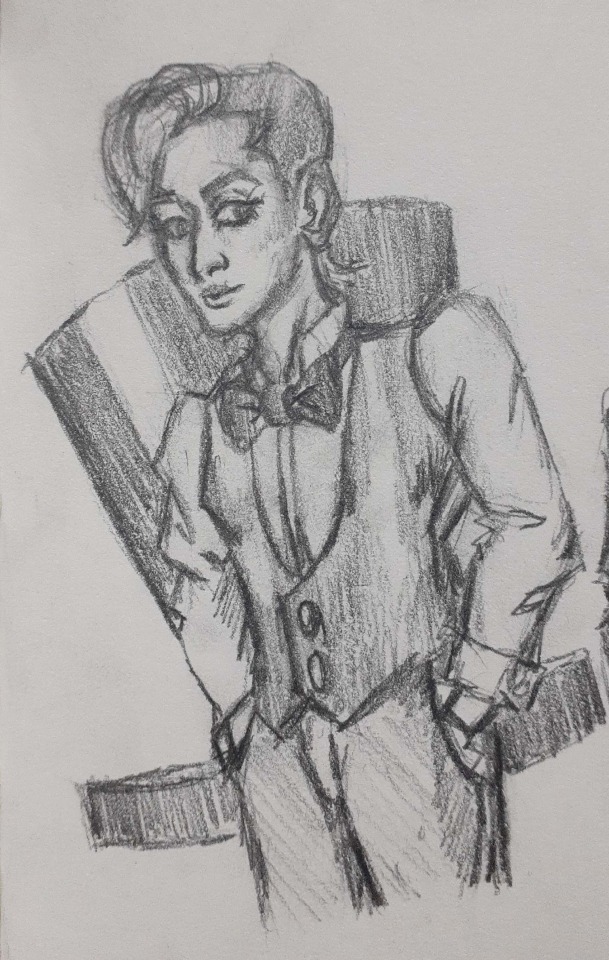
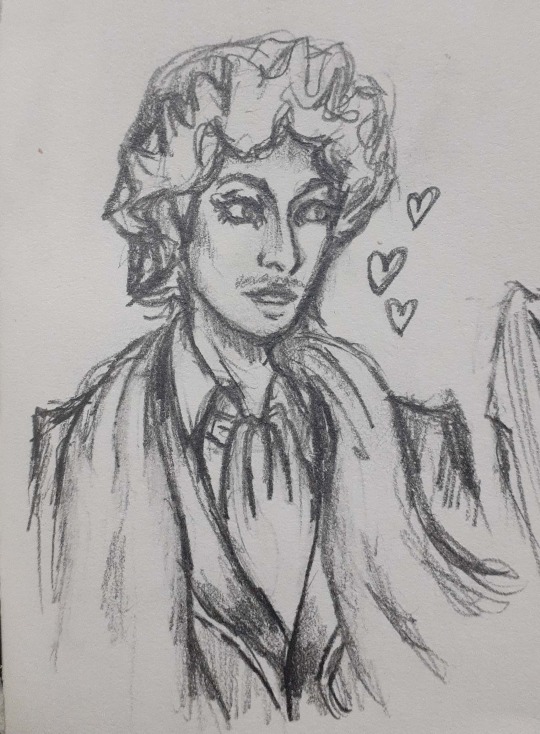
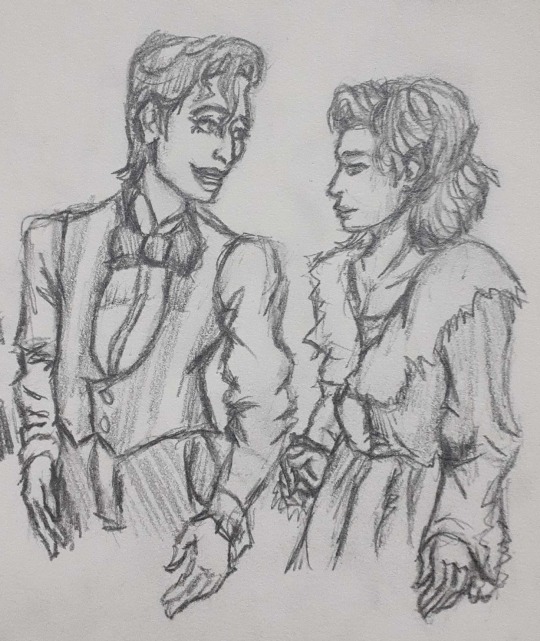
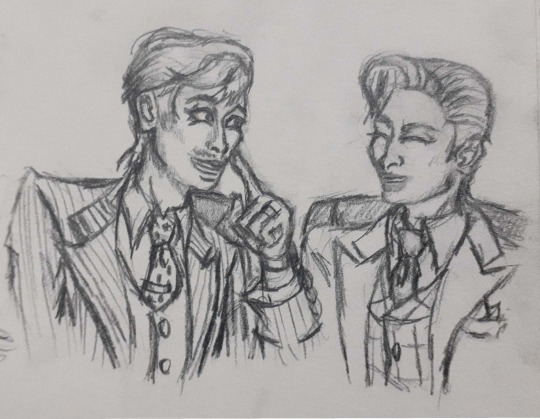
Top Hat quick Sketches! I saw the Shonichi Clips bruh, omg I just wanna see it already and Maiti on a showercap IS TOO CUTE!!!
#Takarazuka Revue#Takarazuka#Top Hat#yuzuka rei#rei yuzuka#minami maito#hoshikaze madoka#hanagumi#sketch#shonichi#jerry travers#dale tremont#horace hardwick#I’m dumping my Takarazuka Sketches here in Tumblr#AND NO WHERE ELSE#If i do get to watch it promise doing fanart fr#I mean do you see those outfits and stage design#chef's kiss#suits#showercap
12 notes
·
View notes
Photo
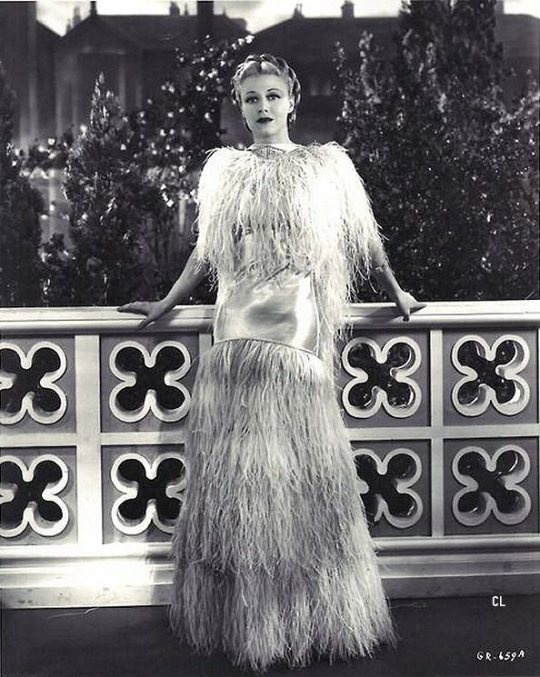



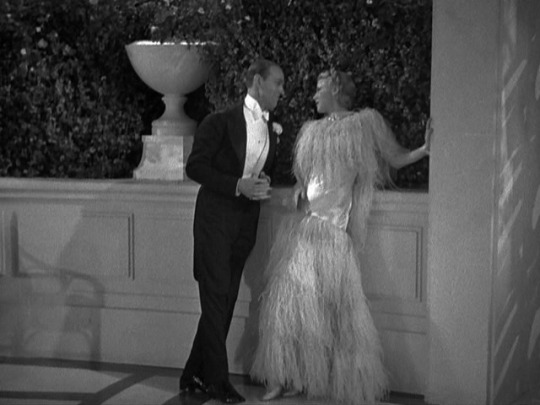


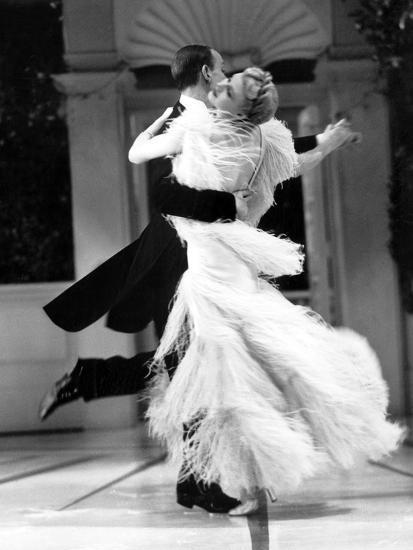

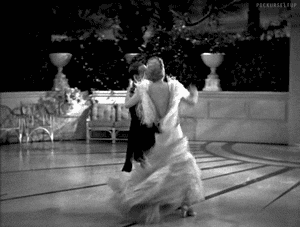
Dale Tremont (Ginger Rogers) Feather dress... Top Hat (1935)... Costume by Bernard Newman...
120 notes
·
View notes
Photo

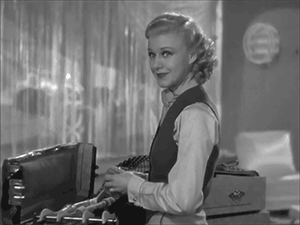
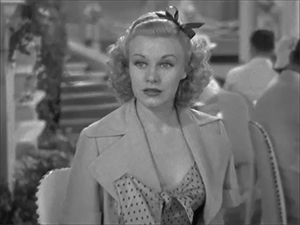
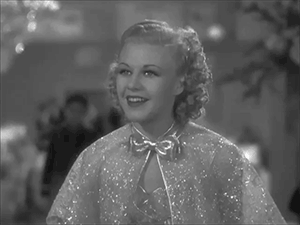



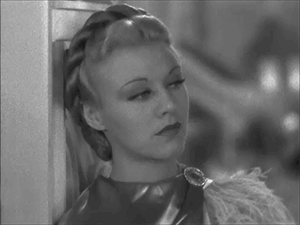

Just Ginger
Top Hat 1935
#Ginger Rogers#Top Hat#1935#1930s#30s#classic fashion#vintage fashion#fashion#classic hollywood#classic#Hollywood#old cinema#old movies#golden age of hollywood#golden era#Dale Tremont#glamour#Style#icon#movie star#star#actress#gifs#gif#gif set#my gifs
14 notes
·
View notes
Photo

5 notes
·
View notes
Photo






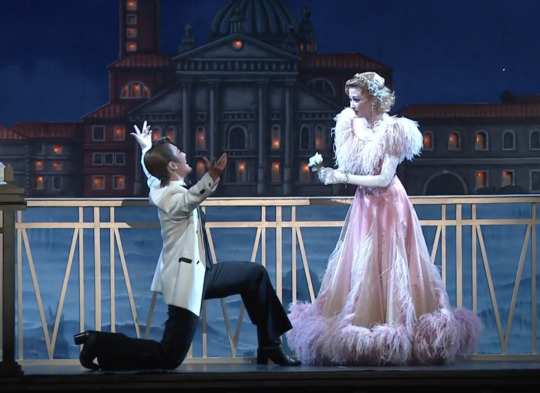
hozumi mahiro as alberto beddini
“oh angelo mio!” – alberto beddini to dale tremont (hoshikaze madoka)
10 notes
·
View notes
Text
Top Hat (1935)
An American dancer named Jerry Travers (Fred Astaire) comes to London to star in a show. He meets and attempts to impress Dale Tremont (Ginger Rogers) to win her affection. Continue reading
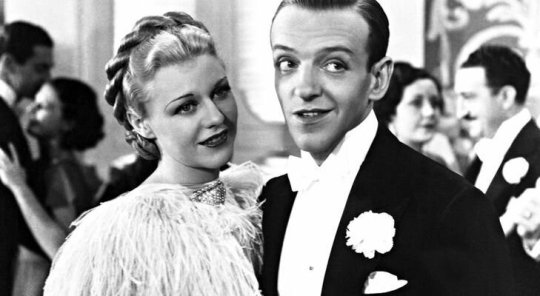
View On WordPress
7 notes
·
View notes
Photo
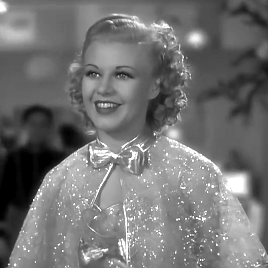
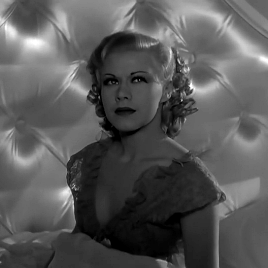






Madge, have you any objections if I scare your husband so that he'll never look at another woman?
Ginger Rogers as Dale Tremont in Top Hat (1935) dir. Mark Sandrich
#oldhollywoodedit#filmedit#userrobin#classicfilmblr#classicfilmsource#musicalsgifs#cinemapix#userthalia#classicfilmedit#old hollywood#classic hollywood#mygifs*#Ginger Rogers#Top Hat#1930s#1935#not sure if this is bad because of me or my copy of the movie 😬#let's just say both#sorry for not giffing isn't it a lovely day!! sabi ko nga ba parang kulang yung dance scenes#also i'm sorry i haven't posting gifs on here as much hopefully once this week over we'll return to our regular programming
838 notes
·
View notes
Text
Astaire & Rogers Rewatch Part 4: Top Hat
• So we’ve reached Top Hat, which is generally everyone’s favorite including @elloette. Even many film historians say it’s the best Astaire/Rogers film. And it’s definitely one of the best but not the best imo. It does however have some of my favorite dances and songs and probably the most famous dance Astaire and Rogers ever created.
• Top Hat is kind of like a more sophisticated version of Gay Divorcee. It also has probably the best example of the Big White Set that was ubiquitous to these films. If I’m not mistaken they dyed the water black to make the set stand out more *goes to check IMDB* yep!
• Our characters/actors: Jerry Travers (Fred Astaire), Dale Tremont (Ginger Rogers), Horace Hardwick (Edward Everett Horton), Madge Hardwick (Helen Broderick), Alberto Beddini (Erik Rhodes)
• I never realized it before but Horace and his valet are like a bickering old couple. In many ways, they make far more sense as a pair than Horace and Madge.
• I’m back again to gush about Astaire’s singing. He slides effortlessly into “No Strings (I’m Fancy Free)” straight from the dialogue, and it sounds perfectly natural. Like the way hb and I integrate Parks and Rec quotes into everyday dialogue, but obviously Astaire is a bit fancier.
• His line about feeling like a sailor at sea is fitting since, in his next film, he will indeed be a sailor.
• This is a favorite solo routine for sure. He’s just so joyful and in the groove. I especially like when he taps out the beat on the side table and startles Horace with short burst of taps.

• Horace thinks he’s such hot shit that some random young woman has come to see him at his hotel late at night.
• Astaire didn’t think he was handsome and didn’t enjoy watching himself on screen, hence the grimace when he looks in the mirror, which is played for a laugh. But that opinion runs contrary to Astaire’s place as one of the leading men of Hollywood and as one part of some of the most romantic moments in film history, primarily with Rogers. It lends credence to Katharine Hepburn’s famous saying that Astaire gave Rogers “class,” and she gave him “sex” (metaphorically). He’s arguably never sexier than when dancing with Ginger Rogers.
• When Dale comes upstairs to tell him to shut up, she gives zero effs. Doesn’t care that he’s trying to be charming or funny, or that he’s sorry for waking her, or that he’s flirting with her, doesn’t care about him at all in any way. Just shut up so I can sleep, is her message.
• But then. She is charmed by his soft shoe dance on a sandy floor to lull her to sleep.
• Spotted: young Lucille Ball as the florist’s assistant. We’ll see her in the next movie too where she’ll have her first ever credited roll.
• Astaire’s face when he asks, “Don’t I even get any thanks?” is so heartfelt and open. It always makes me awwwwwwww.
• Another favorite line of dialogue from these films:
Jerry, holding an umbrella in a downpour: “May I rescue you?”
Dale, unimpressed: “No, thank you. I prefer being in distress.”
• “Isn’t it a Lovely Day?” is a flirtatious song and they act it that way but the true flirting comes in the dance, which is about partnership and equality. They imitate one another throughout the scene, starting even while Astaire is singing. Rogers puts a hand on her chest and he then does the same. They’re dressed alike as well, thanks to her riding outfit, and that furthers the theme by making her more masculine to match him but it’s also advantageous for some of the moves they’ll perform, such as when she lifts him.
• Jerry thinks he’s in control. He’s surprised, but pleased, to find Dale has gotten up and followed him as he begins to dance. He thinks he’s won her over. Then she mocks him a bit by sticking her hands in her pockets like he’s done and surprises him even more by busting out her own little extra tap. She’s telling him she’s not there just to follow his lead and any relationship between them will only work if they’re equals.
• They’re definitely testing each other in this dance, finding out if they are drift compatible. Trying this step and that to see if the other can keep up. She keeps glancing at him in a self-satisfied way. He crosses his arms to see if she’ll do the same. They circle the space mirroring each other with every movement, and while they’re in sync, it’s still like one is leading and the other is following. Until they clap in unison, skip forward, and land at the exact same time. They spin around neatly and he glances over, smiling in pleasure, and so is she.
• The first time they touch is over a minute and a half in and it’s only to lend a hand so each can twirl in turn. They glide forward and back in a wide loop as the music builds and now they’re smiling in earnest and it’s not just the characters; it’s Astaire and Rogers. He mouths something to her, maybe more than once, and they’re both clearly enjoying themselves.

• It’s only in the last 30 seconds or so that they actually touch for real, and it’s because she has crooked her arm in invitation. He spins them around the bandstand together and although it’s a fairly standard move Astaire uses a lot, because they’re both in trousers, you can see just how close they are to one another, knees and hips pressed together.
• And now they combine both elements of the dance: imitation and partnership. They move as reflections of one another and take turns lifting each other. During this portion is where you once again can see the acting stop and the actors just being themselves. As they near the end of the dance, Astaire and Rogers both grin in delight and he maybe looks especially proud of her. This was a technical dance with a lot of movement and she nails it. While her gowns often add to their duets, it’s routines like this, where she’s in trousers, that you can see her technical skill really shine.
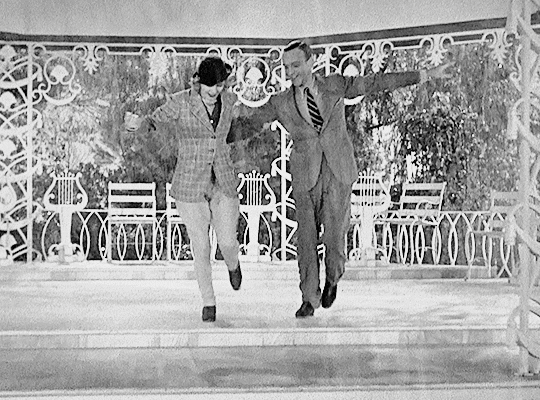
• One of the many ways Rogers contributed to the dancing partnership was in being their “button finder,” which means she was good at figuring out how to end a scene or dance. The best example is at the end of this dance, where she came up with the idea for them to finish by having Jerry and Dale simply shake hands.
• Don’t miss the sex joke in the middle of Horace and Jerry’s argument:
Horace, who is concerned about scandal ahead of Jerry’s show: “Why, I’d rather have had it (getting slapped) happen to me than to you.”
Jerry, not missing a beat: “Oh, of course, if you enjoy that sort of thing.”
Horace: “I do, immensely… (realizing what he’s just said) Now don’t be absurd!”
• Dale’s line, “I hate men. I hate you. I hate all men!” is a mood.
• Beddini’s response, “I am no man. I am Beddini!” is how all men think of themselves.
• Interesting that all we’ve seen Dale and Jerry do is dance a very fun, flirtatious, but not necessarily romantic duet (ok, fine it was in a bandstand while it was raining which is pretty romantic but you get it), and yet she says, “How could he have made love to me when he was married all the time?” 🤔🤔🤔
Further 🤔🤔🤔🤔🤔
Horace: “You sure you didn’t forget yourself in the park?
Jerry: “Positive. If I ever forgot myself with that girl, I’d remember.”
• Seriously, there are some vibes between Horace and his valet. *gaydar pings very quietly out of earshot of the censors*
• I like Astaire’s little warm-up in his dressing room. Seems like the kind of thing he probably did irl.
• One of my absolute favorites moments is when Jerry instructs Horace to charter a plane so they can fly down to meet Dale. Horace asks, “What kind of plane?” And Jerry, already about to miss his stage cue, leans back into the doorway quickly to say, “One with wiiiings!”
• The physical “invitation” Jerry uses when singing the appropriate line in “Top Hat, White Tie and Tails” is actually Madge’s telegram about Dale. He took it on stage with him after snatching it from Horace’s hands.
• There are conflicting stories about how many canes Astaire broke while filming this sequence and which take was used. One account says he broke 12 canes in frustration while failing to get the number absolutely right and the 13th (and last cane) was used in the final take, which was then printed. But Astaire recalled that Jimmy Cagney, who was visiting the set at the time, advised him that he’d nailed it on the second take. Astaire wanted to try a couple more but the next day, agreed that Cagney was right and the second take was used.
• Shooting down his rivals with a cane and using taps for bullets was based on a gimmick Astaire had used years before in a terrible Broadway show. Here it became one of his most iconic creations. I especially like when he fires off a shot at the Horace’s stuffy club members in the audience.
• How on earth did Dale think that Jerry was married to Madge? In what world are they compatible? Granted, she hasn’t actually met Horace but still.
• While Horace is in the bathtub in his shower cap:
Horace: “Jerry! I don’t think it’s safe for you to see that girl alone.”
Jerry: “Well, I don’t think it would be quite proper for you to receive her that way.”

• In most Astaire/Rogers movies, he has a lot of bravado and pursues her but she almost always ends up shocking the hell out of him when she turns out to also be ballsy af. In Gay Divorcee, she invited him to her room. In Top Hat, she comes up to see him alone and then kisses him.
Hardly a romantic kiss btw. But we still aren’t to the place where we talk about the lack of kisses in this film series.
• Aaaaaand again, Astaire’s singing is so perfect for this song. He leads straight from conversation into the lyrics. The music has already been playing in the background, and he makes it appear he’s created the lyrics of “Cheek to Cheek” just for her in this moment.
• Rogers does a magnificent job of softening when he starts to sing. Her eyes flick up and down his face, touched that he’s serenading her. And when Astaire drops his tone on the word “seek,” his gaze is heated for a just a moment and her lips quirk a little. Being sung to is awkward but she makes it seem like the most romantic thing.
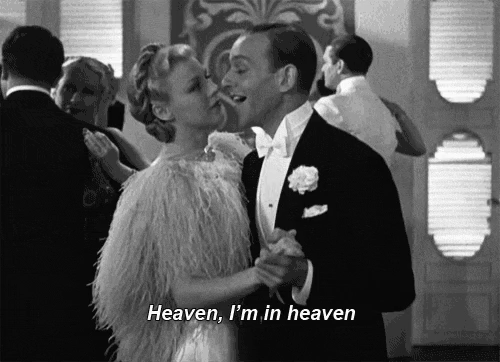
• Like in “Night in Day” in Gay Divorcee, this dance is about seduction but its more developed than in the prior film. Because the characters have already danced together, elements of “Isn’t it a Lovely Day?” seep in, such as the short tap routine they do side by side. Instead of getting her to simply give in to him, he is asking her to trust him, to remember the equality and partnership they’d built before. He almost never takes his eyes off her for the entire dance, even watching her out of the corner of his eye when they’re side by side.
• I would say most of this dance falls into the “acting” category but there are a couple Astaire and Rogers moments that peek through. After the first time he leans her back and them brings them together so their faces are close, he smiles privately to her. After their little tap section, he swings her back into his arms and they’re both smiling in delight.
• A few times the only place they’re touching is his hand on her back and there’s something very Victorian hot about that.
• I’ve always liked the moment where she twirls and he waits, hand outstretched, expression openly adoring, until she takes his hand without looking and they’re in sync again.
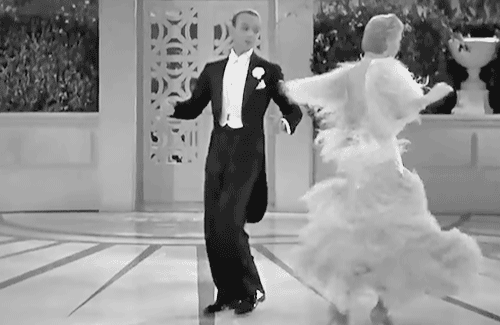
• Another callback to “Isn’t it a Lovely Day?”: In that dance, she crooked her arm in invitation to him. Here, she leaves her arm up so he can wrap it around his neck.
• Several times he leans her back, each time dipping her a little further and keeping her there a little longer, but never failing to hold her and bring her up. Each time showing her she can trust him. When they reach the climax, she bends back completely and he holds her for several looooong seconds before very slowly returning her to her feet. Complete surrender and trust from them both. And after that moment, there is no need for anything else to cement their relationship. He can simply bring them cheek to cheek.
• Something that is evident in most of his partnered dances but perhaps most obvious in a duet like this with Rogers is that Astaire was very good about making his partner the central focus. Your eyes instinctively watch Rogers, not him, throughout the performance. But credit must also be given to Rogers herself for commanding the screen so thoroughly not solely because of her elegant dancing and gorgeous gown but because she remembers to keep acting the entire time. We never doubt that Dale is falling in love with Jerry through this dance.

• Sooo the feather dress. So much to say, some of which you may already know:
The short story is, as soon as they started filming the dance, the feathers on the dress flew everywhere. No one wanted that dress to be used, except Ginger Rogers, and she refused to wear something else.
Director Mark Sandrich, who was a dick to Rogers all the time, wanted her to wear a gown from Gay Divorcee. She told him to GTFO. Then she called her badass mom who came to the set to also tell him to GTFO.
Because they could be little shits, Astaire and Hermes Pan made up lyrics mocking the dress, set to the tune of "Cheek to Cheek.” They went, "Feathers, I hate feathers, And I hate them so that I can hardly speak, And I never find the happiness I seek, With those chicken feathers dancing cheek to cheek."
Rogers was pissed, not in the least because she had designed the dress herself and also they were ostrich feathers tyvm. Tbh it does look pretty magnificent in the final edit of the film… but that was after every single feather had been hand sewn into place. And you can still see some of them float off.
In their next film, Astaire is going to get whacked in the face by the heavy, beaded sleeve of Rogers’ dress so he really had it easy here.
He also knew he’d gone too far in poking fun at her dress and generally being an ass about the entire situation. Astaire apologized to Rogers by giving her a gold feather for her charm bracelet and affectionately calling her “Feathers” in the accompanying note (“Dear Feathers, I love ya! -Fred”). The nickname stuck. Later, he would also give her a beautiful travel watch that was housed in a golden envelope. Engraved on the outside of the envelope in Astaire’s writing? “By Hand/To Feathers/All best love -Fred.”
• The dress is absolutely essential to the dreamy quality of this dance. It makes her look like she’s floating along, caught up in being in love and in his arms. She even seems to come out of a daydream once they’ve finished dancing.
• The plot and dialogue jump through so many hoops to avoid Madge ever once saying, “my husband’s friend, Jerry,” which would clear up everything instantly.
• Interesting that when Dale reminisces sadly about her love for Jerry, whom she doesn’t think she can actually be with, the tune that plays is “Isn’t it a Lovely Day?” and not “Cheek to Cheek.” High romance is lovely but sometimes nothing beats being able to laugh and have fun together.
• Horace and Jerry have been sharing the bridal suite, as it was the only room available when they arrived. But now that Dale has impulsively agreed to marry Beddini, the management asks if Jerry and Horace would be wiling to give up the suite in exchange for a different room.
Jerry: “Well, we’ve hardly settled in it yet… Have we, angel?”
Horace: “No, and all our clothes are...(realizing Jerry is teasing him) Oh, please.”
• Upon finally realizing what’s actually been going on with Dale:
Jerry: “She’s been mistaking me for Horace all this time.”
Madge: “No wonder she thought Horace was fascinating.”
Horace: “Heh, no wonder. (then immediately) I resent that.”
• Perhaps poking fun at the way dances had been filmed until he took charge, Astaire and Rogers’ portion of “The Piccolino” starts with a close up of their feet. But instead of then cutting to a full body shot, the shot widens to show them and the dance continues all in one take.
• This may be a strange place to talk about how right Astaire and Rogers look together but I’m gonna do it anyway. Their heights are very complimentary and they move like extensions of one another. The routine is quick and bouncy, incorporating several styles and switching between them rapidly. Throughout, Astaire and Rogers elevate one another with their individual grace and skill. That element is only going to continue to grow in the next couple of films.
• At one point he whips around to pull her in so they can spin like they did in the bandstand. As she waits for him, Rogers’ face lights up and they go into the move smiling wide. Soon after, Astaire playfully raises his eyebrows to her. At another point, they step forward slowly, eyes on each other, and there’s a glimpse of that private world they sometimes slip into during their dances. The whole time, they’re absolutely flawless.
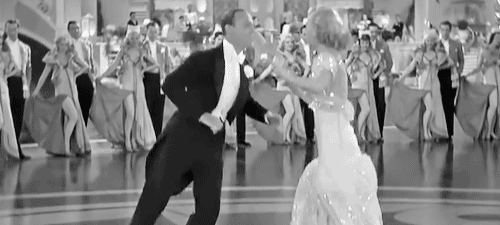
• It wouldn’t have made sense to record the taps, etc live like “I’ll Be Hard to Handle” in Roberta but I wonder what might’ve been picked if they had. Aside from when they clap and there’s no sound, Astaire says something to her when they’re dancing in a circle facing each other. She definitely seems to be giggling at several points.
• When the music kicks up and they go into an energetic section, he bows and flourishes his hand to her, once again making her the main focus.
• While filming the final scene of the movie, Sandrich (the director) wanted the duo to do a short ending dance and he told them this on the day of filming. Astaire and Rogers were peeved. Every bit of dancing, no matter how small, was always rehearsed. But Sandrich, who, again, was a dick, insisted. According to Rogers, she privately told Astaire to simply move her about however he wanted and she would follow along. In all likelihood, they probably did whip up this little dance and rehearse it quickly but you’d never know it wasn’t planned ahead of time.
She obviously had a lot of trust in his ability to lead them both but she also knew he was an excellent social dancer, meaning he didn’t necessarily need a pre-rehearsed routine. And she knew this because they’d gone dancing back in New York when they were dating.
• Here’s a cool behind the scenes picture from The Academy’s archive taken during the final scene.
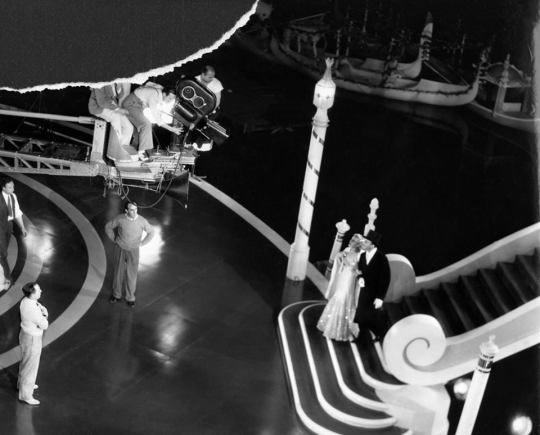
• And so we’ve finished Top Hat, another glamorous adventure for Astaire and Rogers. Up is a more working class outing: Follow the Fleet.
#fred astaire#ginger rogers#top hat#classic hollywood#old hollywood#astaire and rogers rewatch#fred and ginger#any gifs without credit are mine#bc sometimes i just need a specific gif#and no one else has done it or i can't find it#so you're welcome to the three people reading these posts
16 notes
·
View notes
Text
Beside the Foggy Elbe / Estrellas ~ Star Troupe 2019
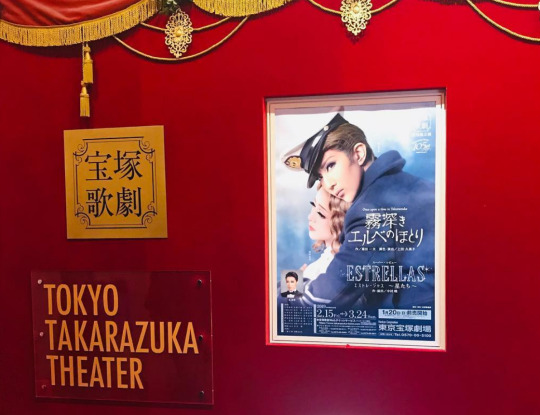
First show of 2019! My home base in Japan is usually Kansai, but for the first time I’m in Tokyo for a lengthy stay. I saw Elbe/Estrellas twice in the theater plus the senshuuraku live view. Spoilers, because the ending of Elbe was one of my favorite things about it.
Beside the Foggy Elbe [Summary]
I caught Elbe quite late in the run, and most of the feedback I heard from talking to other non-Japanese fans beforehand was fairly negative, but I found it VERY enjoyable. Elbe is one of the most historically famous original Takarazuka works. While I haven’t seen more than clips and photos of the older productions, I was already familiar with much of the soundtrack, and I always love seeing and hearing classic Takarazuka elements live, especially as a relatively young fan coming in late in Takarazuka’s 105 year history. It’s a special kind of fun to be able to sit in the theater and sing along (even if only in my head) to a show I’ve never even seen. The story is most definitely dated, but I love the vintage-ness of it (if anything, I wish they’d pushed the aesthetics even more vintage). And because it’s an old classic, I was able to suspend my disbelief of the unlikely love story in the same way I can with old Hollywood musicals (is it believable that Dale Tremont falls in love with Jerry Travers three seconds after finding out he wasn’t actually Horace? No but I’m here for it). I also love that they don’t get together!! The first time I saw it, I looked at the clock when Margit and Florian began yelling for Karl on the docks, and went sort of wide eyed when I realized there wasn’t TIME for it to end any way other than heartbreak. I think it’s much more interesting that way.
Quick complaints out of the way first: while the show isn’t really hard to follow, I did find both Beni and Airi quite difficult to understand. Beni uses a very loud, slurred voice to play the foul-mouthed Karl, and while it’s in keeping with her character, I couldn’t untangle a lot of her words, even though they weren’t lines I’d find complicated if I read them. Airi put on a shrill voice that I also found difficult to understand. I get that her character is an ingenue to the extreme so it makes sense, but I still feel like she could have landed somewhere between that and her natural voice and been ok. Additionally, there is a parade in the beginning that I think was an UeKumi addition. I didn’t DISLIKE it, and I understand its usefulness because it’s a very top heavy show and the parade gives the secondary players a bit of fun extra spotlight, but it didn’t really fit the look or vibe of the rest of Elbe.
I do think you need to like Beni and Airi to enjoy this show, because it is so top heavy (if you love them, I think this will be a really great show for you). I especially liked the role of Karl for Beni. Beni’s Karl was an extremely insecure person who disguised his self-doubt in brash mannerisms and generally poor behavior, which made his moments of sincerity very poignant. Since Beni is known more for her comedic roles than her serious ones, and sometimes seems to be questioned by fans re: her ability to be serious, I thought this really suited her in kind of a meta way. She leaned hard into the brashness because that’s more her strength, but for me she also nailed Karl’s vulnerable moments, and that made them sting extra because it felt like it was coming from a real place. I’m also kind of a sucker for the cross-social-class love story trope. Karl’s behavior for the most part is truly unattractive to the point where it can be hard to sympathize with him, but there are several scenes where you can feel his deep discomfort toward being amongst the wealthy, and how traumatized he is about his ex leaving him because he wasn’t rich enough, and Beni makes them hurt sooooo good (shout out to Otoha Minori who had the very small part of Karl’s ex but really helped succinctly convey that backstory in a way that impacted the whole show).
Margit is a hard sell for me because I don’t find her likable as a character, but I think Airi did a great job hitting the necessary notes. For the story to work, Margit has to be unhappy, but also sheltered, spoiled, frivolous, and naive enough to fall in love with someone she met in a bar at first sight just because he was a little nice to her and the polar opposite of the life she’s trying to escape. Airi made it plausible. She also plays the piano for real a couple of times (angrily!) and I was VERY impressed (Coto also does, but she can’t surprise me with unexpected talents anymore). I think Airi’s strength is sexier more mature characters and I hope she gets to flex that muscle in their taidan show, because in that sense Elbe left a lot to be desired.
As much as I think Karl suited Beni, Coto is the one who made me think it wouldn’t have been quite the same if they’d given Elbe to any current lineup other than Hoshigumi. The least believable part of the entire story is that Florian is too good. There are no men who are that good. Even for the not-men of our 夢の世界 it’s a stretch. But I completely believed that Coto was that good. I don’t even know what to say about her... she can do anything and it’s stupid. Muster up heartbreaking sincerity for a truly unrealistic character? Sure. Play the piano flawlessly while speaking? Why not. (And the way she brushed her coattails out of the way before seating herself at the piano bench made me feel A Way).
The newly inserted Tobias was a nice sendoff for Kai. Not quite as delightful and meaty a role as Kiroku, and not as strong of a goodbye present as Sho Fu Kan, but lovely nonetheless. Tobias was not inherently a remarkable character, but he was an excellent blank canvas on which Kai painted herself, making him cool, hot, and everyone’s big brother—all around lovable. Her costumes made NO sense (cowboy hat??) but she wore them so well I loved them all against my better judgment. Stage time dropped off pretty hard after Beni/Airi/Coto, but the scenes with the other sailors were my favorite, and Kai’s involvement in each was prominent enough (and CUTE enough) to make Tobias feel like a juicy role. She gets a lovely bridge solo toward the end, and fittingly leaves the ship crew to get married (to Mizuno Yuri/Karl’s sister), exiting separately in dramatic fashion to everyone else’s tears and well wishes.
I found myself charmed by the supporting cast—including (especially??) the nameless lurkers of the background—more than usual. Was it the giant food props? Were they just exceptionally silly back there? I don’t know, but unfortunately the recording won’t illuminate them regardless. As for the named support, Mao Yuuki, Seo Yuria, Shidou Ryuu, and Amahana Ema made up the rest of the sailors with lines and stuff, and while there was barely anything for them to do, I (for reasons not entirely known) found Mao and Seo in particular extremely charming. Amato Kanon played a bratty screaming kid, the exact type of role I’d normally find annoying as hell, but she even managed to make HIM charming; she had a lot of very entertaining wordless interactions with some of the bigger players on the outskirts of various scenes while something else was happening in the middle. Mikkii used 5 of her 7 seconds of stage time prowling through the audience, and seeing her angry face advancing head on toward the gaijin seats was indescribably intimidating. The biggest surprise was I fell a little in love with Mizuno Yuri, who, to be fair, did not have to sing OR dance, but who did play a weird lanky adorably awkward country bumpkin with a stupid accent from Karl’s middle-of-nowhere hometown in a way that I for some reason could not stop watching. She, as Tobias’s bride, also bawled her eyes out on raku when the two of them ran off together.
So far I still think Another World is the crown jewel of Benigumi, but I’d place Elbe second.
Estrellas
Seeing Estrellas was an odd experience because it got the New Year’s NHK broadcast, and I watched THAT before I saw it live—how often do you see a Takarazuka video BEFORE seeing the show live?? It’s my personal favorite Benigumi revue thus far. I fell in love with it pretty instantly, and interestingly I think a big part of that was the NHK cinematography, which combined with the song selection made it feel more like a concert or a FNS-style big televised music program. I found that fresh. It didn’t have QUITE that same vibe live, but still a good impact. I can see it being polarizing though; it’s very pop and not very Takarazuka at times, and I probably like it so much because I happen to personally like the song choices.
Allowing for the fact that she was still performing very much within her own quirky style, Beni (up until Tokyo raku) seemed very on point to me, which I was glad to see; my last live Hoshigumi experience was Another World/Killer Rouge in Takarazuka toward the beginning of the run last year, and in Killer Rouge especially it seemed like she was being extremely cautious with her movements in a way that made me wonder if she was nursing or avoiding an injury. Every time I saw Estrellas though she danced full force. Airi had more than one sexy number to make up for Margit, most notably an all musumeyaku dance in the finale portion that I feel like I see pretty rarely from Hoshigumi. Beni and Airi’s duet dance was also VERY cute and very them.
Kai again got a lovely sendoff, a big long 3-song progression with perfectly chosen lyrics. The way she drank in the theater on the last day, like she was really trying to burn the image of the audience into her eyes, was SO much.
Coto is stupid. She paints with her voice and that gets me real bad. There’s a solid handful of siennes in the top tier of vocals in Takarazuka, and while many of them are gorgeous singers, the only two I’ve heard play and emote with their voices the particular way I’m thinking of are Coto and Daimon. Her vocal control while she’s violently dancing is also astounding. She’s stupid.
Senshuuraku was an ordeal! Estrellas opened with Beni doing what I initially thought was some weird attempt at a sexy breathy thing, and then maybe thought she was trying not to cry, till it became abundantly clear that something bigger was wrong. She got hoarser and hoarser till some notes in “Tonight is What it Means to be Young” failed to come out entirely. She used her chuuzume ad lib time to apologize for her voice... sad, because that was the prime slot for cute and touching moments with the retiring actresses, but she was clearly too panicked and struggling to think of that. Then she explained during the curtain call that she broke her voice at the end of Elbe—and it must have been on the VERY last note, because the entirety of Elbe was COMPLETELY fine (I didn’t even notice a weird crack or anything at the end). I didn’t know you could break your voice that badly on one note, but I guess you can. She was very flustered and apologetic—also full on crying—though every curtain call, and while I can’t blame her for feeling remorseful I wish she’d dialed it back after the first couple of apologies and let the retiring actresses have their moment. But considering her state it was pretty remarkable that she powered through, and I hope she has a chance to recover before the next show.
I’ve lived through my share of Takarazuka retirements, including ones that turned a whole troupe’s vibe completely upside down, but somehow Kai’s feels unusually odd (I imagine Miya’s will as well). I think it’s gonna be a downer of a year.
32 notes
·
View notes
Text
Ginger Rogers bizarre moment she's recognised as Barbara Stanwyck unearthed | Films | Entertainment
Ginger Rogers bizarre moment she’s recognised as Barbara Stanwyck unearthed | Films | Entertainment
Tonight, Ms Rogers stars opposite her long-time collaborator Fred Astaire in the timeless classic Top Hat, which airs from 9pm on BBC Four. The musical comedy follows the story of Jerry Travers, who spots Dale Tremont, and instantly falls in love with her, before worrying that he might actually be married to her best friend. Ms Rogers and Mr Astaire became icons of the Golden Age of Hollywood,…

View On WordPress
0 notes
Photo
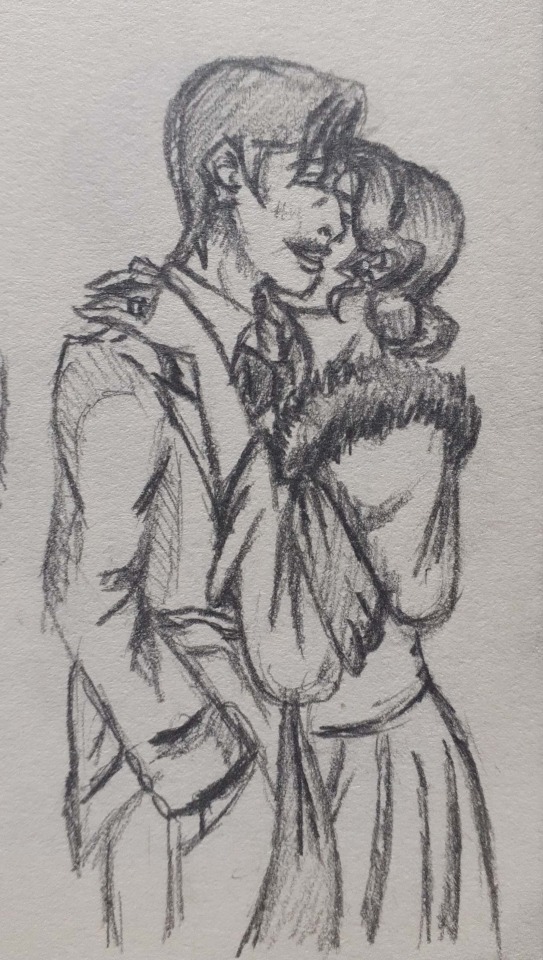
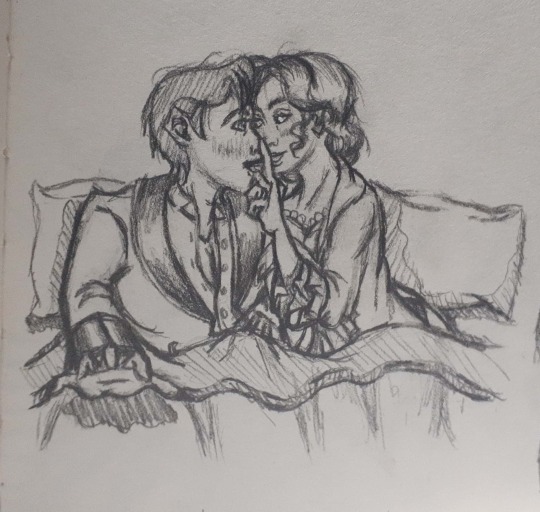
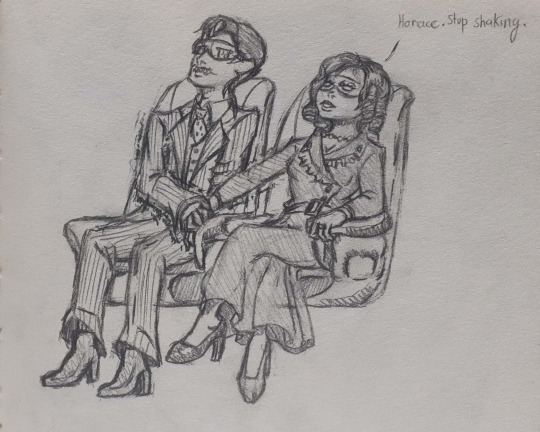
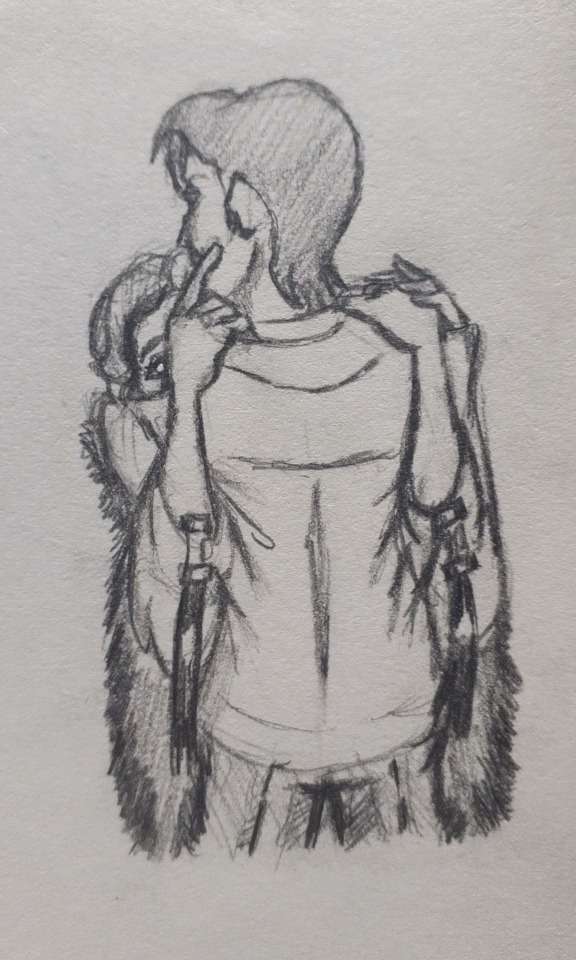
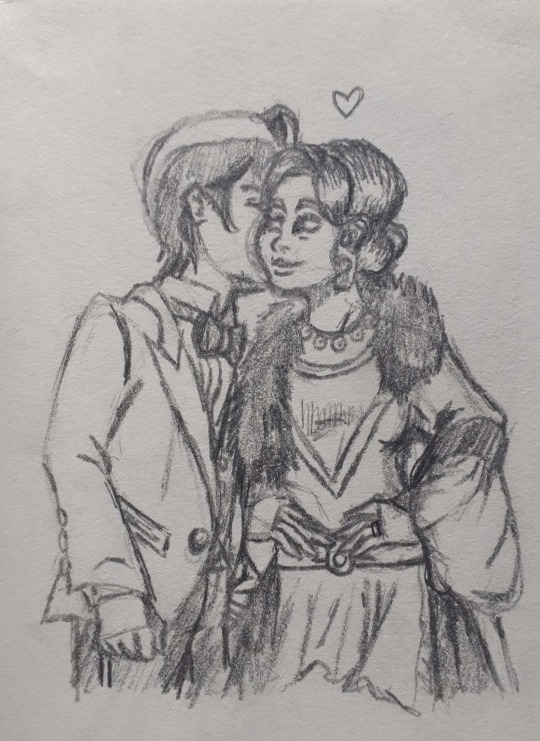
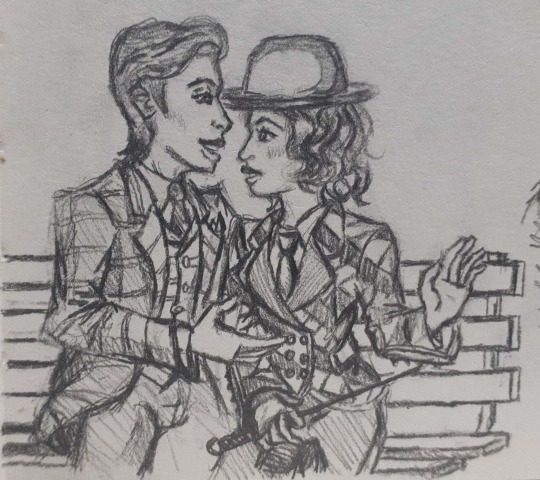
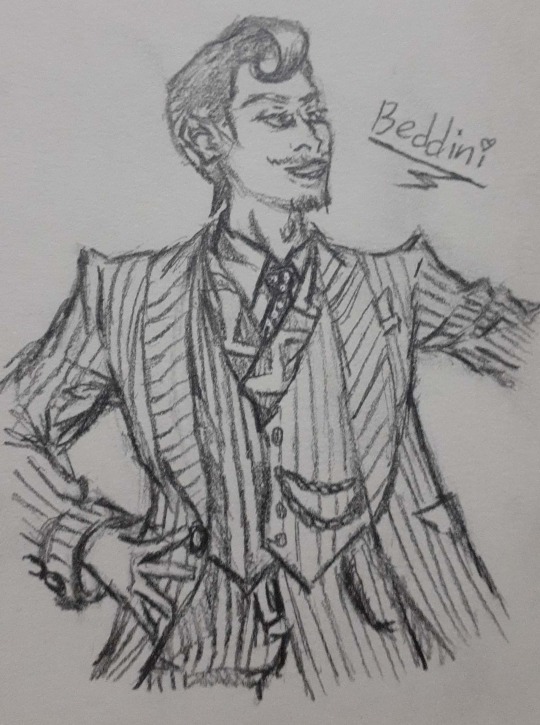
Did Some Top Hat Sketches! Tho it was more Horace x Madge tbh (Oto K TT^TT) Idk why but Maiti and Oto K made their relationship a lot cuter than the 2015 version. Also, Beddini ❤️
#takarazuka revue#takarazuka#top hat#tophat#minami maito#oto kurisu#yuzuka rei#hoshikaze madoka#hozumi mahiro#hanagumi#sketch#horace hardwick#madge hardwick#Alberto Beddini#jerry travers#dale tremont#Horace and Madge just kissing each others cheeks through out the show counter when#Jerry & Dale just got engaged and the it's two anniversary#They ended up sharing rooms and stuff happens so...lets keep it PG#Seeing Horace freak out with Jerry in a Plane made me wonder what if its Madge#Could be the reason these two don't fly together now that i think about it HAHAHA#I squeezed ReiMado somewhere there#Alberto in this play is for some reason is almost my..ideal man...i mean i like how he dresses and is a designer...soooo#Proceeds to dump in tumblr ikr#wait up im doing horace in a showercap art
4 notes
·
View notes